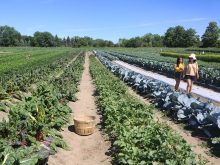Nearly all hybrid rye in Alberta is grown under irrigation with the top producer averaging 180 bushels last year. Most other hybrid rye growers saw 140 bu.
Alberta’s hybrid rye scene is different from that in Saskatchewan and Manitoba, where FP Genetics’ Brasetto and Bono are the only varieties.
The only hybrid rye grown in Alberta is Guttino, sold through Stamp Seeds at Enchant and the 13 members of SeedNet, a partnership of seed growers. All three varieties are owned by the German company KWS.
Greg Stamp said only 30 producers grow this hybrid rye. Twenty-five percent of hybrid rye production isn’t even aimed at the premium milling and distilling market. Instead, it’s grown solely for silage.
Read Also

Crop quality looks good this year across Prairies
Crop quality looks real good this year, with the exception of durum.
“One of our customers is Kolk Farms,” Stamp said.
“They run a feedlot near Iron Springs, and they’ve silaged hybrid rye for three years in a row. It spreads out the work for their silage chopper because the rye is ready for cutting before the corn. They say the economics are actually quite good, about on par with the corn.
“We had kind of a localized drought around here in 2016. My dryland growers who were hardest hit averaged 100 bu. on their Guttino. Their traditional rye was down around 70 bu. When there’s drought stress, the hybrids just take off and pull away from the OPs. I’ve seen the hybrids with as much as a 40 percent yield advantage under extreme drought stress.”
A lot more than 25 percent of the Guttino goes to feed when the weather turns wet at harvest. However, there are a number of outlets for quality rye when producers get a dry harvest.
“We’re at a freight disadvantage to Minneapolis, but we sell some into B.C. and some to Calgary and Lethbridge for distilling,” he said.
“We shipped some into Sask-atchewan this year. Some of my customers are able to load rail cars, so they have more market options.”
Stamp and his customers have seeded 6,000 acres of Guttino.
















